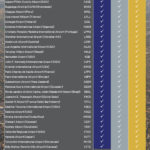More posts by this contributor
Higher education is being transformed by COVID-19, but it goes beyond universities simply “going remote” to try and cope. The changes afoot are holistic, transformative and a long time coming. These changes will extend to recruiting, training and, ultimately, how employers fundamentally go about finding potential candidates for their organizations. It also will change the very nature of higher education itself.
Before COVID-19, would-be employees would take traditional educational routes to gain employment. High school led to college, which (sometimes) led to grad school. Almost all of this was done in an immersive campus setting where students tried to figure out not only who they were but what they wanted to do and with whom they wanted to do it. This path required enterprises to react specifically to an entrenched educational model that determined how would-be employees would be groomed and trained — be it for a specific skill set or cultural fit — all in an effort to determine who the right person was for them.
This model has grown bloated over the years, and the industry that supports it — projected to register $10 trillion globally by 2030 — has become increasingly vulnerable to the kind of technology-driven change that, over the last decade, has been disrupting old-school industries across the board, from retail to logistics to real estate and more.
“A reckoning is coming for schools and universities,” Scott Galloway, a professor of marketing at the NYU Stern School of Business, told CNN in late May. “We’ve raised prices 1400% but at the same time, if you look at innovation … if you walked into a classroom today it wouldn’t look, smell or feel much different from what it did 40 years ago.”
In a blog post from April, Galloway further projected that COVID-19 would lead to a culling among universities. As with retail, he suggested — where closures skyrocketed from 9,500 stores in 2019 to more than 15,000 in 2020 — there will likely be dozens, if not hundreds, of colleges and universities that simply do not recover from the virus. He also predicted a sustained drop in applications at four-year universities for the first time in decades.
“The blow to the world of higher education was bound to come,” said Roei Deutsch, co-founder and CEO of live video course marketplace Jolt Inc. during a talk on the podcast, Coffee Break. “There is a higher education bubble, something there does not work in terms of cost versus what students receive in return, and you can say that the coronavirus crisis is the beginning of this bubble’s bursting.”
While the virus may hasten an overdue transformation in higher education, it also will create opportunities for startups that create alternatives to traditional higher education. As with many other sectors, though, this will be less about COVID-19 acting as a radical change agent and more about the virus accelerating what was already taking place behind the scenes, primarily within global enterprises.
Over the last decade, enterprise learning and development (L&D) has grown in importance as various technologies proliferated throughout large organizations. The global corporate e-learning market is estimated to grow up to $30 billion at a 13% compound annual growth rate through 2022. This growth was driven in large part by the increased importance of matching workforce capabilities with actual required skill sets.
Learning experience platforms (LXP) and learning management systems (LMS) are core products used by enterprises in L&D. They are used to monitor, track and administer employment learning activities. They usually serve as digitized online catalogs. Learning software is primarily designed to create more personalized learning experiences and help users discover new learning opportunities by combining learning content from different sources, while recommending and delivering them — with the support of AI — across multiple digital touch points, e.g., desktop applications, mobile learning apps and others.
Significantly, these same online education tools have also begun to be adopted by many colleges and universities as they look for ways to cope with COVID-19. This is helping to transform thinking around these applications, tools and platforms. Enterprises, which had already been adopting these tools, are now reconsidering their potential. It does not take a colossal leap of imagination to see what lies ahead.
Instead of building training academies and LMS systems to help continually train people for new or expanded roles within an organization, enterprises will now target the front end of the recruiting funnel where higher education begins. With university life transformed by COVID-19, it has opened up the possibility for enterprises to reassess how they participate in that funnel. The potential for global enterprises to own the university experience is, suddenly, very real.
Imagine leveraging these existing education and training platforms to create hyperspecific curricula for enterprises. A gig economy for professors who have been displaced from shuttered universities could provide the online faculty. They’ll design a curriculum specifically suited to an enterprise’s needs.
These new enterprise-driven, online university systems will vet people for academic excellence and cultural alignment to determine who they want to educate and, ultimately, hire. And all of it will feed them directly into their own systems. These would be university systems not unlike what we see today with, say, The U.S. Naval Academy, where a tuition-free education comes with an obligation to serve for a period of time. Others have speculated that a kind of hybrid, for-profit model that blends universities and global enterprises may also emerge.
“MIT/Google could offer a two-year degree in STEM,” suggested Galloway. “MIT/Google could enroll 100,000 kids at $100,000 in tuition (a bargain), yielding $5 billion a year (two-year program) that would have margins rivaling … MIT and Google. Bocconi/Apple, Carnegie Mellon/Amazon, UCLA/Netflix, Berkeley/Microsoft … you get the idea.”
Higher education is not the only system poised for fundamental transformation. The U.S. staffing and recruiting market, whose total size was already predicted to decrease 21% due to the coronavirus outbreak, could also see changes in how they operate. No longer will enterprises feel obliged to recruit at universities or utilize the tools, platforms and resources necessary to identify recruits coming out of these outdated systems. Now, they’ll have a direct funnel to employees perfectly attuned to their needs. This would be a boon for enterprises that would not only create novel profit centers in their organizations but would also avoid the costly and inefficient process of searching for employees common to most recruiting models today. The savings are not insignificant.
The cost of a bad hire can reach up to 30% of the employee’s first-year earnings, according to the U.S. Department of Labor. Undercover Recruiter looked at misadventures in hiring potentially costing enterprise $240,000 in expenses related to hiring, compensation and retention. One study found that 74% of companies that admit they’ve hired the wrong person lost an average of $14,900 for each bad hire, according to CareerBuilder.
Then there are the ancillary benefits for students — the cost of higher education has been skyrocketing for decades, and student debt has reached unacceptable levels, with diminished earning power associated with degrees. A tipping point is fast approaching: One study demonstrated that a college degree decreases in value as the number of graduates increases. So, in Sub-Saharan Africa (where degrees are relatively rare) a degree will boost earnings by more than 20%. In Scandinavia (where 40% of adults have degrees) that number drops to 9%.
These new, enterprise-specific universities would provide real, tangible ROI on every education investment dollar made. The promise of specific jobs upon graduation with good salaries is doubly important in a shaky economy. As universities continue to price themselves out, they’ll have a tougher time justifying their costs, particularly when juxtaposed against an online educational system that feeds directly into Google, Twitter or Microsoft. It would likely prove irresistible for many students.
The secondary effects of COVID-19 as it relates to higher education are still not clear, but a possible picture is beginning to emerge. Recruiting could have to transform who they target and how (and when) they go about it. A burgeoning industry that has been supporting a steadily increasing appetite from enterprises for digital education and training could be transformed overnight and grow by leaps and bounds. Students could see debt cut in half and have a clear path forward toward employment. Whatever the ultimate landscape is that emerges, the changes in store for universities and colleges will undoubtedly be unpleasant.
“I think we’ve stuck out the mother of all chins and the fist of COVID-19 is coming for us,” Galloway told CNN. “Think of another industry that charges 100K and gets 90-plus points of margin. Other than a pharmaceutical for a drug that cures a rare cancer, maybe, what other product gets that kind of margin? Quite frankly, we’ve had this coming.”
That some kind of change is coming seems clear, but whether a paradigm shift in education is a good thing is less so. Like most industries disrupted by software and technology, tremendous value will flow to millions of consumers as technologies drive market efficiencies. There will be jobs that vanish or are transformed and there will be new jobs that are created to satisfy the new way of doing things. Major global enterprise and tech companies stand to profit the most from this transformation, with more wealth and power flowing into the hands of the FAANGs of the corporate world.
There will also be a reshaping of priorities in higher education as intellectual discovery, cultural appreciation and individual growth — the hallmarks of a campus-based liberal arts education — are replaced by the pursuit of a narrowly defined set of vocational skills and corporate efficiencies. The implications of global enterprises wading into higher ed will change not only how we educate, hire and train people but how we fundamentally think about and value higher education, as well.

Powered by WPeMatico







